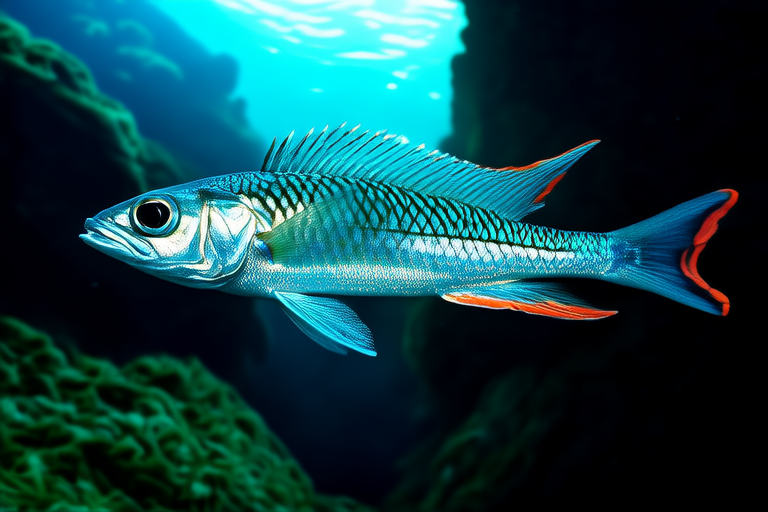Top 10 Fascinating Facts About the Rajah Cichlid
The Rajah Cichlid, scientifically known as Vicariancea rajah, is a captivating species of fish that has garnered significant attention among aquarium enthusiasts. Native to the freshwater rivers of Borneo, this cichlid boasts a rich history and intriguing biology that makes it a standout choice for aquarists. This article delves into ten fascinating facts about the Rajah Cichlid, offering insights into its habitat, behavior, diet, and unique characteristics.
1. Native Habitat and Preferred Water Conditions
The Rajah Cichlid hails from the pristine waters of Borneo, specifically the tributaries of the Kapuas River. It thrives in environments characterized by clear, fast-flowing water with abundant vegetation. The ideal water parameters for this species include a pH range of 6.5 to 7.5, a temperature between 75°F and 82°F (24°C to 28°C), and moderate hardness levels. These conditions mimic the natural habitats of the Rajah Cichlid, ensuring optimal health and vitality in captivity.
2. Distinctive Appearance and Identification
One of the most striking features of the Rajah Cichlid is its vibrant coloration. Males exhibit a dazzling array of colors, including shades of blue, red, and yellow, while females tend to have more subdued hues. The males also display elongated dorsal and anal fins, which they use during courtship displays. This visual distinction makes it relatively easy for aquarists to identify the sex of their Rajah Cichlids.
3. Behavior and Social Dynamics
Rajah Cichlids are territorial by nature, particularly during breeding seasons. They establish and defend specific areas within their aquatic environment, often engaging in aggressive behaviors to ward off intruders. Despite their territorial tendencies, these cichlids can coexist peacefully with other non-aggressive species when provided with ample space and hiding spots. Understanding and managing their social dynamics is crucial for maintaining a harmonious aquarium environment.
4. Diet and Feeding Habits
The Rajah Cichlid is primarily carnivorous, feeding on small insects, crustaceans, and other aquatic organisms in its natural habitat. In captivity, a balanced diet consisting of high-quality pellets, flakes, and occasional live or frozen foods such as brine shrimp and bloodworms ensures optimal nutrition. Providing a variety of food options promotes healthy growth and vibrant coloration in these fish.
5. Breeding Habits and Reproduction
During the breeding season, male Rajah Cichlids construct elaborate nests by moving gravel and sand into piles. Once a suitable nest is established, the male engages in courtship displays to attract a mate. After successful mating, the female lays her eggs in the nest, which the male then fertilizes. Both parents exhibit strong parental care, guarding the eggs and fry until they are capable of fending for themselves. This level of dedication underscores the importance of creating a stable and secure environment for breeding purposes.
6. Unique Adaptations for Survival
The Rajah Cichlid possesses several adaptations that enhance its survival in its native environment. Its streamlined body shape allows for efficient swimming in fast-moving waters, while its keen eyesight aids in locating prey and detecting potential threats. Additionally, the species has developed a tolerance for varying water conditions, enabling it to thrive in different parts of its riverine habitat.
7. Interaction with Other Species
Rajah Cichlids can coexist with various other species, but careful selection of tankmates is essential to prevent conflicts. Peaceful community fish such as tetras, barbs, and some loaches make suitable companions. However, it’s important to avoid housing them with overly aggressive or highly territorial species, as this can lead to stress and potential injuries.
8. Conservation Status and Threats
The Rajah Cichlid faces several threats in the wild, including habitat destruction due to deforestation and pollution. Conservation efforts are crucial to ensure the survival of this species and its ecosystem. Aquarists can contribute to conservation by supporting sustainable breeding programs and avoiding the collection of wild specimens for the pet trade.
9. Captive Care and Maintenance
Maintaining optimal water quality is paramount for the health of Rajah Cichlids. Regular water changes, proper filtration, and monitoring of water parameters help create a stable and healthy environment. Additionally, providing hiding spots and caves can alleviate stress and promote natural behaviors. With appropriate care, these cichlids can live up to 10 years in captivity, making them a rewarding addition to any aquarium.
10. Cultural Significance and Mythology
In addition to its ecological importance, the Rajah Cichlid holds cultural significance in Borneo. Local communities have long revered this species, incorporating it into traditional stories and folklore. Some myths attribute special powers or protective qualities to the Rajah Cichlid, further highlighting its role in the cultural fabric of the region.
Understanding and appreciating the Rajah Cichlid goes beyond merely keeping it in an aquarium. By delving into its native habitat, behavior, and cultural significance, we gain a deeper connection with this remarkable species. Whether you’re a novice or an experienced aquarist, the Rajah Cichlid offers a wealth of knowledge and enjoyment, making it a truly fascinating subject of study and admiration.
